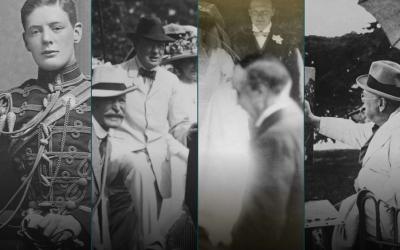Winston Churchill and his connection to Britain's Greatest Palace
Sir Winston Churchill, a towering figure in 20th-century history, shared a profound and enduring connection with Blenheim Palace that went beyond the realms of politics and war. Blenheim served as Churchill's birthplace and became a significant backdrop throughout his life.

When was Winston Churchill born?
Churchill was born into the aristocratic Spencer-Churchill family on 30th November 1874 at Blenheim whilst his parents were visiting and staying at the Palace. Growing up, he attended boarding school and would return to Blenheim for the holidays. Blenheim Palace went on to become a place where Churchill would regularly return for parties, to paint, to spend time with friends, and he also chose to propose to his wife within the Palace grounds.
Winston stated, ‘At Blenheim, I took two very important decisions: to be born and to marry. I am content with the decision I took on both occasions.'

When was Winston Churchill Prime Minister?
Churchill first became Prime Minister in May 1940, leading the nation through some of the darkest hours in its history. Despite this, he was ousted from power when the Conservatives lost the general election of 1945. Clement Attlee became Prime Minister, and the Labour Party remained in power until 1951. Winston spent the following five years painting and writing.
Churchill became Prime Minister again on 26th October 1951. He was a month short of his 77th birthday.

What political party was Winston Churchill?
Winston began his political career as a conservative MP for Oldham in 1900, but defected to the Liberal Party in 1904 and quickly rose to prominence in the Liberal government. He became Home Secretary in February 1910 and First Lord of the Admiralty on 25th October 1911; he was still in post at the start of World War I.
However, after disastrous campaigns at the Dardanelles and Gallipoli, Winston was demoted and resigned from government. He returned to the Army serving as an officer on the Western Front, until he was appointed to join David Lloyd George’s collation government as Minister of Munitions in 1917.

Winston re-joined the Conservative party in 1924, but lost his seat in the General Election of 1929. This was the start of a period known as his Wilderness Years, where he was out of political office. He spent most of this time writing and making speeches.
When Britain declared war on Germany on 3rd September 1939, Winston was asked to join the Cabinet as First Lord of the Admiralty. In February 1940, Prime Minister Chamberlain invited him to join the Supreme War Council. Winston was asked to become Prime Minister when Germany invaded France in 1940.

Where did Churchill propose to his wife, Clementine?
Many significant moments of Winston’s personal life took place at Blenheim including his proposal to Clementine Hozier on 11th August 1908 at the Temple of Diana in the grounds of the Palace.
Winston and Clementine married on 12th September 1908 at St Margaret’s Church in Westminster. They spent the first three nights of their honeymoon at Blenheim Palace before travelling to Italy.

What was Churchill's family life like at Blenheim Palace?
Following their marriage, Winston and Clementine had five children: Diana (1909), Randolph (1911), Sarah (1914), Marigold (1918) and Mary (1922).
The family spent many Christmases at Blenheim. Winston’s children would also visit, and they would sign the Visitor Book, marking their name with an ‘X’ if they were too young to write it out in full.
When did Churchill die?
Winston Churchill died at his London home on 24th January 1965, when he was 90 years old following a series of strokes. Churchill was buried at St Martin’s Church in Bladon, alongside his father, his mother, his brother, and his children. The Church can be seen from the south-facing State Rooms in the Palace.
A State Funeral was held for Winston Churchill on 30th January 1965 at St Paul’s Cathedral. It was broadcast live by the BBC and was the biggest national event since the Coronation of Elizabeth II in 1953. Churchill is one of only four prime ministers to have received a state funeral, the others being The Duke of Wellington, Viscount Palmerston and William Gladstone. Churchill knew he was to be accorded a State Funeral – he planned it with the Duke of Norfolk – it was code-named Operation Hope Not.
After the funeral service, his body was brought back to Oxfordshire by steam train. As General de Gaulle was due to be in attendance, Churchill had arranged for the train to leave from Waterloo station rather than its usual departure place, Paddington!
Image on the left: The First Duke of Marlborough. Image on the right: Young Winston Churchill
Discover more about Winston Churchill
Explore our Churchill exhibition when you visit us at Blenheim Palace, or browse our website which gives an insightful picture of Churchill and his connection to Britain's Greatest Palace.










